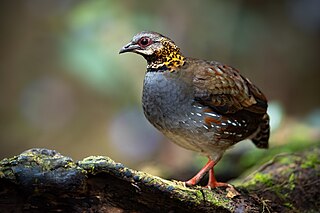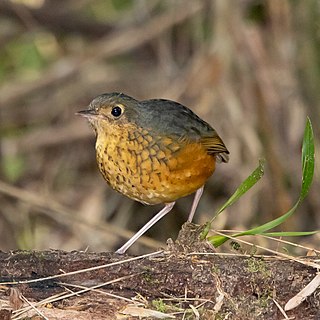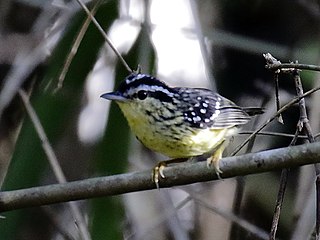
The grey-breasted prinia or Franklin's prinia is a wren-warbler belonging to the family of small passerine birds found mainly in warmer southern regions of the Old World. This prinia is a resident breeder in the Indian subcontinent, Sri Lanka and southeast Asia. Like other prinias, it often holds the tail upright but it is easily told by a smoky grey band across the breast which contrasts with a white throat. The beak is all black while the legs are pink. The tail is graduated as in other prinias and the grey feathers are tipped in white. In the breeding plumage the upperparts are grey while non-breeding birds are pale above with rufous wings and a weak supercilium. It is found in scrub, forest clearings and other open but well vegetated habitats. It can be confused with the rufescent prinia.

The trocaz pigeon, Madeira laurel pigeon or long-toed pigeon is a pigeon which is endemic to the island of Madeira, Portugal. It is a mainly grey bird with a pinkish breast; its silvery neck patch and lack of white wing markings distinguish it from its close relative and probable ancestor, the common wood pigeon. Its call is a characteristic six-note cooing, weaker and lower-pitched than that of the wood pigeon. Despite its bulky, long-tailed appearance, this pigeon has a fast, direct flight.

Bolle's pigeon, Bolle's laurel pigeon or dark-tailed laurel pigeon is a species of the genus Columba of family Columbidae, doves and pigeons, endemic to the Canary Islands, Spain. This bird is named after the German naturalist Carl Bolle, who was the first to distinguish it from the laurel pigeon. This wood pigeon is endemic to the laurel forest habitat.

The red collared dove, also known as the red turtle dove, is a small pigeon which is a resident breeding bird in the tropics of Asia. The male has a blue-grey head and a red-brown body. The female is much plainer, with pale brown plumage similar to that of the larger Eurasian collared dove.

Wallace's fruit dove is a species of a bird in the pigeon family Columbidae. The name commemorates the British naturalist Alfred Russel Wallace. It is a rather large, long-tailed fruit dove with a length of 24–28 cm (9.4–11.0 in) and has been described as "one of the most beautiful" fruit doves. The forehead and crown are dull crimson, the lower face and throat are white, and the rest of the head, breast, neck, and upper back are pale bluish-grey. The wings and lower back are green and the belly is orange, separated from the chest by a white band. Both sexes look similar, but females have less extensive red on the head and a greenish tinge to their grey parts.

The African olive pigeon or Rameron pigeon is a pigeon which is a resident breeding bird in much of eastern and southern Africa from Ethiopia to the Cape. Populations also are found in western Angola, southwestern Saudi Arabia and northern Yemen. It is locally common, although sizeable gaps in its distribution occur due to its habitat requirements.

The pale-capped pigeon, also known as the purple wood pigeon, is a species of large pigeon that is found patchily distributed in parts of the Indian subcontinent and Southeast Asia. It has a slow flight and spends a lot of time sitting still in the foliage of large fruiting trees, often in riverine forest on the plains. It is mainly brown above and chestnut below with the a sheen of green or amethyst. Males have a whitish grey cap while females have a brownish grey cap and less gloss on the feathers. They are frugivores, foraging in small groups in the canopy of trees but sometimes descending to the ground for seeds and fallen fruit.

The pink-browed rosefinch is a finch in the family Fringillidae. Nicholas Aylward Vigors first described the species in 1831. It is migratory and ranges across the northern regions of the Indian subcontinent, mainly in the Himalayas. It is found in Bhutan, Tibet, India, Nepal, and Pakistan. Its natural habitats are boreal forests, shrub-lands, grasslands, and dry forests.

The rufous-throated partridge is a species of bird in the family Phasianidae. It is found in montane forests in India and Southeast Asia. The International Union for Conservation of Nature (IUCN) has assessed it as a least-concern species.

The island bronze-naped pigeon, also known as the São Tomé bronze-naped pigeon or São Tomé pigeon, is a species of bird in the pigeon family, Columbidae. It is endemic to the Gulf of Guinea, where it is found on the islands of São Tomé, Príncipe, and Annobón. It inhabits rainforest, secondary forests, and plantations at elevations of up to 1,668 m (5,472 ft), although it is more common at lower elevations. A small, darkish pigeon, it has a total length of 28 cm (11 in). Adult males have slate-grey heads and upper backs, blackish-grey wings, backs, and tails, buffy-white throats, ashy-grey breasts and bellies, and rufous vents. The back of the neck and upper back are glossy pink or green, while the wings have a green tinge to them. Females are similar, but have browner undersides, duller and less glossy upperparts, and more rusty-orange outer tail feathers.

The white-bellied imperial pigeon is a species of bird in the pigeon family Columbidae. First described by the French ornithologist Charles Lucien Bonaparte in 1854, it is endemic to Indonesia, where it is found on Sulawesi, Buton, Taliabu, Togian, and Peleng. It inhabits primary forest, dense secondary forest, and isolated areas of hill forest. A large pigeon with a long tail, it measures 42.5–51.5 cm (16.7–20.3 in) long and weighs 510 g (18 oz) on average. Males are mainly green, with pale-grey heads and bellies, chestnut vents, and a pale grey tail band, along with a red orbital ring. Females are nearly identical, but have darker grey areas in their plumage.

The Papuan mountain pigeon is a species of bird in the pigeon family, Columbidae. It is found in the Bacan Islands, New Guinea, the D'Entrecasteaux Islands, and the Bismarck Archipelago, where it inhabits primary forest, montane forest, and lowlands. It is a medium-sized species of pigeon, being 33–36 cm (13–14 in) long and weighing 259 g (9.1 oz) on average. Adult males have slate-grey upperparts, chestnut-maroon throats and bellies, whitish breasts, and a pale grey terminal tail band. The lores and orbital region are bright red. Females are similar, but have grayish breasts and grey edges to the throat feathers.

The barred cuckoo-dove is a bird species in the family Columbidae. It is native to South and Southeast Asia, and listed as Least Concern on the IUCN Red List.

The pin-tailed green pigeon or pin-tailed pigeon is a species of bird in the family Columbidae native to Southeast Asia.

The speckle-breasted antpitta is a species of bird in the family Grallariidae. It is found in Argentina, Brazil, and Paraguay.

The speckled antshrike or spiny-faced antshrike is a Near Threatened species of bird in subfamily Thamnophilinae of family Thamnophilidae, the "typical antbirds". It is found in Colombia and Panama.

The red-headed trogon is a species of bird in the family Trogonidae.

The yellow-breasted warbling antbird or yellow-breasted antwarbler, is a species of bird in subfamily Thamnophilinae of family Thamnophilidae, the "typical antbirds". It is found in Bolivia, Brazil, and Peru.
The olive pigeons are four allopatric species of pigeon, named for their association with olive (Olea) species. They have a maroon tone to the speckled plumage, and inhabit cool, montane forests of Africa and its associated islands. Together with the speckled wood pigeon, they are seen as members of a superspecies, which has affinities with the white-naped pigeon.
Wood pigeon, wood-pigeon or woodpigeon may refer to:






















